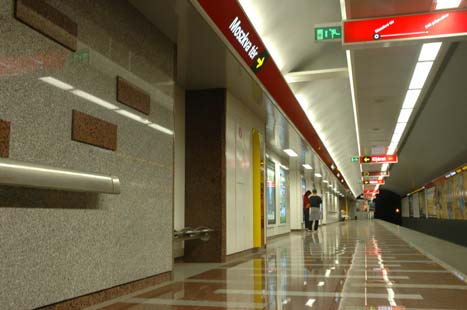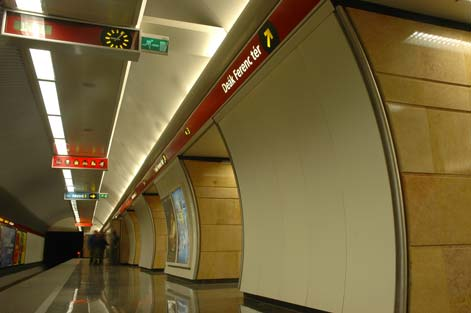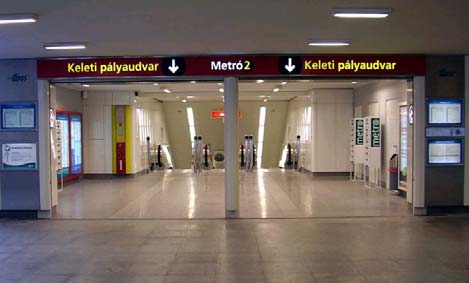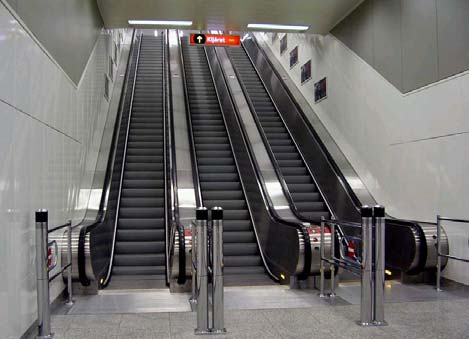| Company Portrait | Quality System | Organigram |
| Board of Directors | Memberships |
Contact |
| Management | History |
Maps |
Design of metro lines and tunnels



Location:
Principal:Budapest Transport Ltd.
Year:2002
Revenue:
Length of line: 10.4 km
Number of stations: 11
Transporting capacity: 26 700 persons/hour/direction
Number of passengers/year: 116 million (average)
Speed: 32 km/h
- Design document for approval by authorities
- Tender document
Preliminaries:
The line M2 of the Budapest metro network was put into operation in two phases, in 1970 and in 1972.
9,0 km of the line is situated in an underground tunnel, 1,0 km is a surface section.
The line has 11 stations, out of which 9 are constructed under the surface and 2 on the surface. The construction of the line began in 1950, with the realization of the underground structures. As a consequence, the age of these structures was 32-52 years in 2002, while the continuous operation time reached 30-32 years. During the 3 decades of operation, which practically was not disturbed by significant traffic troubles, the structures and the technical equipment became aged and obsolete; making the reconstruction unavoidable.
Description of the works:
Waterproofing of the underground structures
Elimination by packer and screen injection method of the water infiltrations, becoming more and more serious due to the construction errors. In insurmountable cases the infiltrating water is drained into a drainage system. As a result of the reconstruction the quality of the waterproofing system reached an “acceptable” level.
Stations, surface buildings
During the 30 years operation time the parts of the line, which became the most obsolete from the point of view of the passengers’ comfort are the interior building structures.
After the reconstruction the passenger areas became up-to-date, aesthetic, made of durable materials, reflecting the image characterizing the Budapest metro. At the “Stadionok” station the traveling comfort of the disabled was improved by the realization of elevators and escalators. At the “Pillangó utca” station elevators were installed for the disabled, elderly people and for those carrying weighs during their travel. Based on the operation experiences and using the international examples, a modern system of passenger information was realized. Within the frame of the reconstruction works a second exit was realized at “Keleti pályaudvar” station.
Railway track
The superstructure composed of UIC 54 rails, which are well regulated, durable, flexible and needing minor maintenance, allows a further 20-30 years of safe train traffic on the line.
The subdrain system built in the track substructure improves the life expectancy of the track.
Power supply
All the elements of the power supply system, at all voltage levels, were changed and replaced for modern devices and elements (switches, main- and sub-distributors, electrical protection, control and transmission technical equipment, fireproof cables etc.), from the 10kV equipment to the luminaries passenger area. The life expectancy of these new devices is 20-30 years. During the reconstruction further power supply remote control switches were installed, reducing the time of resolving the eventual operation troubles.
Railway signaling system
As a result of the reconstruction the tasks related to the signaling system and train control system are carried out by electronic IT devices and methods.
The ATP part of the automatic train control system offers a continuous guarantee – free from human control – for the respect of the preset speed limit of the trains, realizing in this way the “one-man” operation.
The ATO part of the continuous train control system ensures an energy efficient traffic and facilitates the train drivers’ work.
Telecommunication devices
The telecommunication and transmission technical system installed on cable and wireless system ensures highly safe and economic information flow, with up-to-date equipment of standard system. The optical cable system allows the transmission of large quantity image information to the center and thus the creation of the position ‘passenger traffic central dispatcher”. In this way – according to the international practice – the trains control and the passengers surveillance is carried our by independent logistics. Considering the requirements of our time, the concept of the industrial TV system changed; allowing not only the surveillance of the places risky from the point of view of traffic, but it is extended to the entire passenger area.
HVAC
The reconstruction embraced the whole spectrum of the facility, by replacing the aged and amortized equipment. An important new element of the system is a multi-element fire protection system, suitable for complex heat- and smoke removal.
The parts of the system are the following: main ventilation with increased capacity adjustable upon the requirements, water mist extinguishers, jet-fan ventilation in the inclined shaft, ensuring a smoke-free escape route.
Construction
The reconstruction was carried out with a continuous harmonization of the operation, design and execution. The metro line was kept operating during the reconstruction period, by partial and temporary limitation of the traffic, with due respect of the contractual deadline.
Within the reconstruction project the work phases necessitating major traffic limitation periods were timed for the months of the summer holiday, and implemented only on certain sections of the line. In the periods of interruption on the track the metro traffic was substituted by surface bus passenger transport.
Aiming at the consistent observance of this principle the several years’ process of the stations’ reconstruction was divided into the following main phases:
- 2004 Blaha Lujza tér, Kossuth tér
- 2005 Astória, Batthyány tér, Keleti pályaudvar
- 2006 Deák tér, Moszkva tér, Déli pályaudvar
- 2007 Stadionok, Pillangó utca, Örs vezér tér
The reconstruction of the line sections was also harmonized with the above scheduling, determined by the possibility of traffic sectioning on the entire line.
The following sections can be operated independently:
- Déli pályaudvar - Deák tér
- Deák tér - Stadionok
- Stadionok - Őrs vezér tér
However the reconstruction of the running tunnels and the tracks was carried out according to a much more complex scheduling, occasionally with partial operation served by shuttle services.
Some pictures showing reconstructed stations:




Name of contact officer: Mr. Zoltán Vajda, Chief Engineer (Chief Engineer Office for Metro Reconstruction and Operation)
Telephone number of contact officer: +(36-1)-267-6526